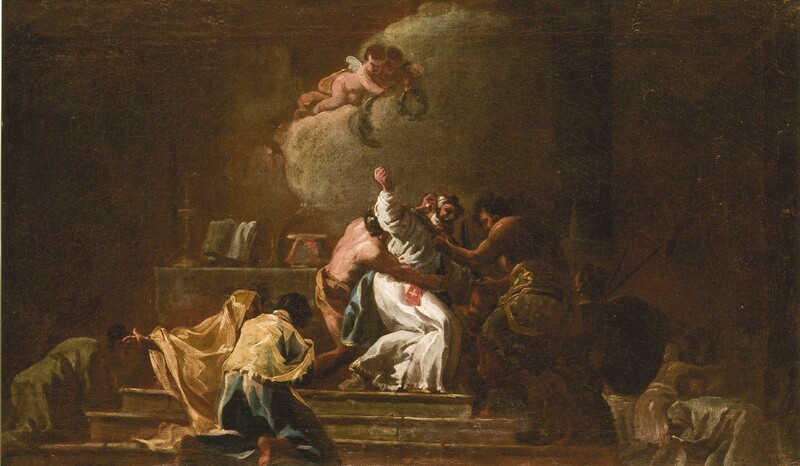- Cronología
- Ca. 1772 - 1774
- Dimensiones
- 35 x 60 cm
- Técnica y soporte
- Oil on canvas
- Reconocimiento de la autoría de Goya
- Attributed work
- Titular
- Private collection
- Ficha: realización/revisión
- 26 Aug 2021 / 12 Jun 2023
- Inventario
- 225
See the previous painting The Escape into Egypt, of the same provenance and with which it forms a pair.
Saint Albert of Jerusalem was a Catholic saint, Bishop of Vercelli and Patriarch of Jerusalem in the 12th and 13th centuries. Jerusalem between the 12th and 13th centuries. He is remembered as the first legislator of the Carmelites. Carmelites. On 14 September 1214 he died at St. John of Acre (formerly Acco) murdered by the Master of the Hospitallers of the Holy Spirit, whom he had admonished and then deposed. admonished and then deposed from office for his licentious life. The work shows
various aspects of Goya's hand that correspond to the period in which it was painted, such as the way he sketches the figures in the background, the loose, precise brushstrokes that build up the volumes and the the loose, precise brushstrokes that build up the volumes and the play of light and shadow in the nocturnal setting. nocturnal setting. The half-naked figure holding Saint Albert by the waist shows Goya's good knowledge of the Goya had acquired a good knowledge of anatomical representations on his return from Italy, both from his from classical sculpture as well as from life. As in the work The Sacrifice of Jephthah's Daughters, Goya shows the moment before a tragic event.
This work is also closely related to the scenes of the life of the Virgin in the Charterhouse of Aula Dei, so we can date them around the same time. In addition, the drawing “Academy of a priest with open arms” from the Italian Notebook (p. 10), whose figure is analogous to that of St. Albert, has been linked to this work.
-
2008
-
Goya y Zaragoza (1746-1775). Sus raíces aragonesasMuseo Goya. Colección IbercajaZaragoza2015cat. 15
-
Servicios de Publicaciones de la Universidad de Castilla- La Mancha,2008pp. 34-35
-
Madrid2014pp. 96-107
-
Goya y Zaragoza (1746-1775). Sus raíces aragonesasZaragozaFundación Goya en Aragón, Ibercaja y Gobierno de Aragón2015pp. 134-136

